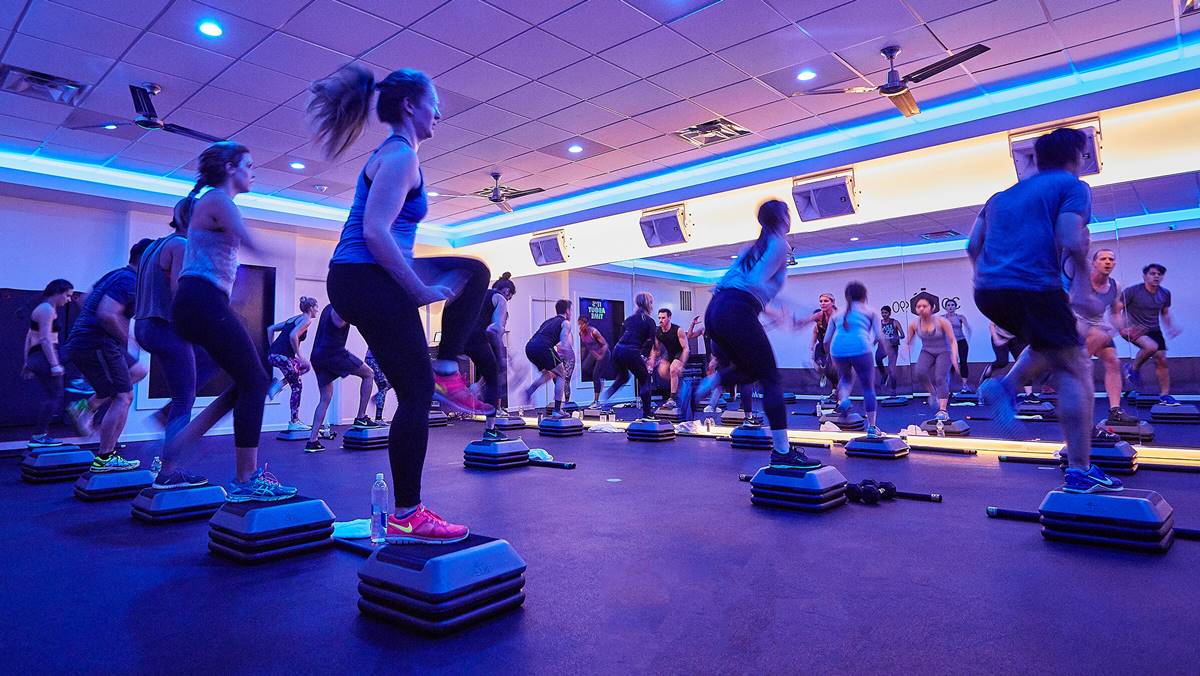

Featured
What Is High Intensity Exercise
Modified: January 2, 2024
Discover the benefits of high-intensity exercise with our featured guide. Increase your fitness level and burn calories in less time with these challenging workouts.
Introduction
High Intensity Exercise, often referred to as HIIT (High Intensity Interval Training), has gained significant popularity in recent years. This form of exercise involves short bursts of vigorous activity followed by brief recovery periods. It is a time-efficient and effective way to boost fitness levels, burn calories, and improve overall health.
With our increasingly busy lifestyles, finding the time to prioritize exercise can be a challenge. That’s where high intensity exercise can be a game-changer. In just a fraction of the time compared to traditional workouts, high intensity exercise can provide numerous benefits for both physical and mental well-being.
Whether you are a beginner looking to kickstart your fitness journey or an athlete seeking to take your performance to the next level, high intensity exercise can be tailored to suit your individual needs and goals. In this article, we will explore the definition of high intensity exercise, delve into its benefits, discuss different types of high intensity workouts, and provide tips on how to incorporate it into your routine.
So get ready to push your limits, challenge your body, and achieve new milestones with high intensity exercise!
Definition of High Intensity Exercise
High Intensity Exercise is a form of training that involves intense bursts of physical activity followed by short periods of rest or recovery. The key characteristic of high intensity exercise is the effort exerted during the intense intervals, which pushes individuals to work close to their maximum capacity.
Unlike steady-state exercises, such as jogging or cycling at a moderate pace, high intensity exercise involves pushing your limits for shorter durations. This type of training challenges multiple energy systems in the body and increases the heart rate significantly.
Typically, high intensity exercise is performed in intervals of 20-60 seconds, with recovery periods ranging from 10-60 seconds. The ratio of work to rest can vary depending on individual fitness levels and goals, but the general principle is to work at a high intensity and then allow the body to recover before repeating the cycle.
High intensity exercise can be adapted to various forms of physical activity, including running, cycling, swimming, bodyweight exercises, and even weightlifting. The intensity can be adjusted by manipulating factors such as speed, resistance, incline, and duration of the intervals.
It’s important to note that the high intensity nature of this exercise puts significant stress on the body. Therefore, it is recommended to consult with a healthcare professional or fitness expert before starting a high intensity exercise program, especially if you have any underlying health conditions or are new to exercise.
Now that we have a clear understanding of what high intensity exercise entails, let’s explore the many benefits it offers.
Benefits of High Intensity Exercise
High Intensity Exercise offers a wide range of benefits that can positively impact both your physical health and overall well-being. Here are some key benefits of incorporating high intensity exercise into your routine:
- Increased Cardiovascular Fitness: High intensity exercise elevates your heart rate and challenges your cardiovascular system. As a result, it helps improve your cardiovascular fitness, leading to a stronger heart and improved circulation.
- Improved Metabolic Function: High intensity exercise can boost your metabolism for hours after the workout. This means that even after you finish exercising, your body continues to burn calories at an accelerated rate.
- Enhanced Fat Burning: High intensity exercise is highly effective at burning fat. The intense bursts of activity force your body to tap into its energy stores, including stored fat, to meet the high demand for energy.
- Increased Muscle Strength and Endurance: High intensity exercise challenges your muscles, leading to increased strength and endurance. It can help build lean muscle mass and improve overall body composition.
- Time Efficiency: One of the major advantages of high intensity exercise is its time efficiency. You can achieve significant benefits in a shorter period of time compared to longer, moderate-intensity workouts.
- Enhanced Athletic Performance: High intensity exercise can improve your speed, power, and agility, making it beneficial for athletes across various sports.
- Mood Boost: High intensity exercise triggers the release of endorphins, the “feel-good” hormones, which can boost your mood and help reduce stress.
- Improved Mental Focus: The intense nature of high intensity exercise requires focus and concentration, which can enhance cognitive function and mental clarity.
These are just a few of the many benefits that high intensity exercise can offer. Incorporating this type of training into your routine can have a positive impact on your overall health and well-being.
Types of High Intensity Exercise
High intensity exercise can be performed in various ways, allowing individuals to choose a method that suits their preferences and fitness goals. Here are some popular types of high intensity exercise:
- HIIT (High Intensity Interval Training): HIIT involves alternating between short bursts of intense exercise and periods of rest or active recovery. This can be done with bodyweight exercises, cardio exercises like sprinting or cycling, or a combination of both.
- Circuit Training: Circuit training involves completing a series of exercises targeting different muscle groups with minimal rest in between. It combines strength training and cardiovascular exercise, making it an effective form of high intensity exercise.
- Tabata: Tabata is a specific form of high intensity interval training that follows a 20-second work interval followed by a 10-second rest interval. This pattern is repeated for a total of four minutes, typically involving one or more exercises.
- Pyramid Training: Pyramid training involves gradually increasing and then decreasing the intensity or duration of exercises within a workout session. This creates a challenging workout that helps improve both endurance and strength.
- EMOM (Every Minute on the Minute): EMOM workouts involve performing a specific exercise or set of exercises at the start of every minute for a set duration, followed by rest for the remainder of the minute. The goal is to complete the designated number of reps within each minute.
- Fartlek Training: Fartlek means “speed play” in Swedish and involves alternating between periods of fast and slow running. It is a flexible and customizable form of high intensity exercise that can be adapted to outdoor running or treadmill workouts.
These are just a few examples of the different types of high intensity exercise. The key is to find a method that aligns with your interests, fitness level, and availability of equipment or space.
Remember to warm up before starting a high intensity workout and cool down afterward to prevent injury and aid in recovery.
How to Incorporate High Intensity Exercise into Your Routine
Adding high intensity exercise to your fitness routine doesn’t have to be complicated. Here are some tips to help you incorporate it into your daily regimen:
- Start Slow and Progress Gradually: If you’re new to high intensity exercise, start with shorter intervals and lower intensity. Gradually increase the intensity and duration as your fitness level improves.
- Choose Activities You Enjoy: Select activities that you find enjoyable and that align with your interests. Whether it’s running, cycling, or bodyweight exercises, incorporating activities you like will make it easier to stick to your routine.
- Mix Up Your Workouts: Keep your workouts interesting and prevent boredom by incorporating a variety of high intensity exercises. This can include different types of interval training, circuit training, or trying out new exercises regularly.
- Use Timers or Apps: Consider using timers or fitness apps that provide guidance and structure for your high intensity workouts. These tools can help you keep track of your intervals and rest periods, making your workouts more efficient.
- Combine High Intensity with Low Intensity: Balance your high intensity workouts with lower intensity exercise, such as walking or gentle stretching, on rest days or as recovery sessions. This will help prevent overtraining and reduce the risk of injury.
- Find an Accountability Partner: Pairing up with a workout buddy or joining a high intensity exercise class can help keep you motivated and accountable. Having someone to share your fitness journey with can make the process more enjoyable and ensure you stay on track.
- Listen to Your Body: Pay attention to your body’s signals and adjust the intensity or duration of your workouts as needed. It’s important to challenge yourself, but not at the cost of overexertion or injury.
Remember, consistency is key when it comes to high intensity exercise. Aim for at least two to three sessions per week to start seeing the benefits. Be patient with your progress and give your body adequate time to recover between workouts.
By incorporating high intensity exercise into your routine, you can achieve remarkable fitness results and improve your overall health and well-being.
Safety Considerations for High Intensity Exercise
While high intensity exercise can be a highly effective and rewarding form of training, it’s important to prioritize safety to prevent injury and ensure a positive experience. Here are some key safety considerations to keep in mind:
- Consult with a Healthcare Professional: Before starting a high intensity exercise program, especially if you have any underlying health conditions or are new to exercise, it’s important to consult with a healthcare professional. They can assess your fitness level and provide guidance tailored to your specific needs.
- Warm Up Properly: Always dedicate a few minutes to warm up before starting your high intensity workout. This can include dynamic stretching, light cardio exercises, or movements that prepare the specific muscles you’ll be targeting.
- Progress Gradually: Avoid pushing yourself too hard too quickly. Gradually increase the intensity, duration, and frequency of your high intensity workouts to allow your body to adapt and minimize the risk of overuse injuries.
- Focus on Proper Form: Maintain proper form during each exercise to maximize effectiveness and minimize the risk of injury. If you’re unsure about proper technique, consider working with a qualified fitness professional who can guide you.
- Listen to Your Body: Pay attention to any signals of pain or discomfort during your workouts. If you experience sharp or persistent pain, dizziness, or shortness of breath, stop exercising and seek medical attention if needed.
- Stay Hydrated: Make sure to hydrate adequately before, during, and after your high intensity workouts. Dehydration can negatively impact performance and increase the risk of injury.
- Allow for Adequate Recovery: Give your body sufficient time to rest and recover between high intensity workouts. This includes getting enough sleep, incorporating active recovery sessions, and prioritizing proper nutrition.
- Modify or Scale Movements: If you’re unable to perform certain exercises with correct form or at the recommended intensity, don’t hesitate to modify or scale the movements. This can involve using lighter weights, adjusting the range of motion, or choosing alternative exercises that are more suitable for your fitness level.
- Listen to Expert Advice: When participating in high intensity exercise classes or following an online workout program, listen to the instructions and guidance provided by qualified trainers or instructors. They can provide valuable insights and help ensure your safety.
By following these safety considerations, you can minimize the risk of injury and make your high intensity exercise experience both safe and enjoyable.
Conclusion
High Intensity Exercise, also known as HIIT, offers a multitude of benefits for individuals looking to enhance their fitness, burn calories, and improve overall health. Its time efficiency, versatility, and ability to deliver results make it an attractive option for people with busy schedules.
Throughout this article, we’ve explored the definition of high intensity exercise, discussed its benefits, and highlighted various types of workouts that fall under this category. Whether it’s HIIT, circuit training, Tabata, or other forms of interval-based workouts, there are plenty of options to choose from.
When incorporating high intensity exercise into your routine, it’s important to prioritize safety by consulting with a healthcare professional, warming up properly, progressing gradually, focusing on proper form, and listening to your body’s cues. Additionally, staying hydrated, allowing for adequate recovery, and modifying movements can contribute to a safe and effective experience.
Remember, high intensity exercise can be adapted to suit individuals of all fitness levels and goals. Customize your workouts, find activities you enjoy, and add variety to keep your routine engaging and challenging.
So, whether you’re a fitness enthusiast or just starting your fitness journey, consider incorporating high intensity exercise into your routine. Push your limits, boost your fitness level, and reap the many benefits that this form of exercise has to offer!









